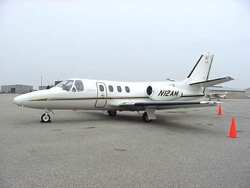Tue, Sep 15, 2009
Pilot Failed To Fly A "Stabilized Approach"
 The NTSB has determined that pilot
error was the cause of a 2007 incident in which two people were
killed when a Cessna 500 skidded off a wet runway during landing,
hit a house adjacent to the airport, and exploded on impact.
The NTSB has determined that pilot
error was the cause of a 2007 incident in which two people were
killed when a Cessna 500 skidded off a wet runway during landing,
hit a house adjacent to the airport, and exploded on impact.
The crash killed the pilot, 72-year-old Hugh Rains of Wichita
Falls, Texas, and 71-year-old Janet Brady of Conway, who was in her
home. The plane hit Brady's house after impacting the airport jet
blast deflector and running through the perimeter fence. One
passenger on board the aircraft survived the crash
VFR conditions prevailed at the time of the accident, but there
was standing water on the runway due to an earlier rain shower.
The NTSB probable cause report says:
The twin-engine turbojet airplane was attempting to land on a
runway with standing water when the accident occurred. Before the
landing attempt, the pilot was told that the runway was wet from a
recent rain shower. Witnesses reported seeing the airplane on the
runway traveling at a high speed and then increase engine power to
abort the landing with about 1/4 of the runway remaining.
The surviving passenger reported that the runway was "soaked and
shiny with water." He stated that the airplane landed hard and
fishtailed during the landing roll. During the aborted landing the
airplane impacted a jet-blast deflector located off the departure
end of the runway. The airplane then proceeded through the airport
perimeter fence and impacted a residential structure before coming
to a stop. The airplane and residential structure were destroyed
during a postaccident fire. An examination of the airframe and
engines did not reveal any anomalies associated with a preimpact
failure or malfunction. The airplane was not equipped with thrust
reversers or an anti-skid braking system. Radar track data analysis
indicated that when the airplane was about 1/4 mile from the end of
the runway it was approximately 16 knots above its target landing
reference speed (Vref) and had a descent rate of 1,150 feet per
minute. The runway was 4,875 feet long. The calculated landing
distance for a runway with standing water is 4,789 feet.

Cessna Citation 500 File
Photo
The National Transportation Safety Board determines the probable
cause(s) of this accident as follows. The pilot's failure to fly a
stabilized approach and his delayed decision to abort the landing.
Contributing to the accident was the standing water on the
runway.
More News
He Attempted To Restart The Engine Three Times. On The Third Restart Attempt, He Noticed That Flames Were Coming Out From The Right Wing Near The Fuel Cap Analysis: The pilot repor>[...]
Make Sure You NEVER Miss A New Story From Aero-News Network Do you ever feel like you never see posts from a certain person or page on Facebook or Instagram? Here’s how you c>[...]
From 2009 (YouTube Edition): Leading Air Show Performers Give Their Best Advice for Newcomers On December 6th through December 9th, the Paris Las Vegas Hotel hosted over 1,500 air >[...]
Aero Linx: NASA ASRS ASRS captures confidential reports, analyzes the resulting aviation safety data, and disseminates vital information to the aviation community. The ASRS is an i>[...]
“For our inaugural Pylon Racing Seminar in Roswell, we were thrilled to certify 60 pilots across our six closed-course pylon race classes. Not only did this year’s PRS >[...]
 NTSB Final Report: Rutan Long-EZ
NTSB Final Report: Rutan Long-EZ ANN FAQ: Turn On Post Notifications
ANN FAQ: Turn On Post Notifications Classic Aero-TV: ICAS Perspectives - Advice for New Air Show Performers
Classic Aero-TV: ICAS Perspectives - Advice for New Air Show Performers ANN's Daily Aero-Linx (06.28.25)
ANN's Daily Aero-Linx (06.28.25) Aero-News: Quote of the Day (06.28.25)
Aero-News: Quote of the Day (06.28.25)




